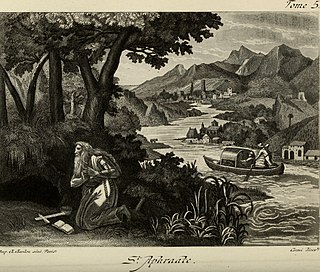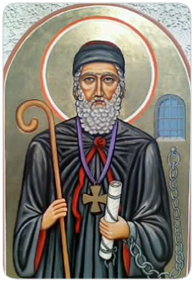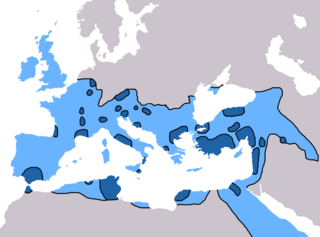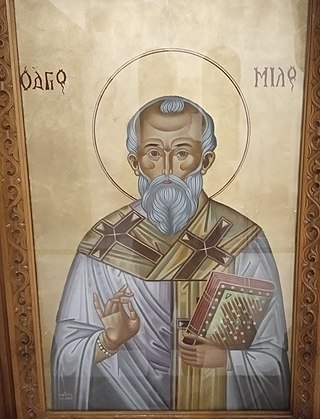
Ctesiphon was an ancient Iranian city, located on the eastern bank of the Tigris, and about 35 kilometres (22 mi) southeast of present-day Baghdad. Ctesiphon served as a royal capital of the Iranian empire in the Parthian and Sasanian eras for over eight hundred years. Ctesiphon was capital of the Sasanian Empire from 226–637 until the Muslim conquest of Persia in 651 AD.

Yazdegerd I was the Sasanian King of Kings of Iran from 399 to 420. A son of Shapur III, he succeeded his brother Bahram IV after the latter's assassination.
A catholicos is the head of certain churches in some Eastern Christian traditions. The title implies autocephaly and, in some cases, it is the title of the head of an autonomous church. The word comes from ancient Greek καθολικός, derived from καθ' ὅλου from κατά and ὅλος, meaning "concerning the whole, universal, general"; it originally designated a financial or civil office in the Roman Empire.
The Maphrian, originally known as the Grand Metropolitan of the East and also known as the Catholicos, was the second-highest rank in the ecclesiastical hierarchy of the Syriac Orthodox Church, right below that of patriarch. The office of a maphrian is an maphrianate. There have been three maphrianates in the history of the Syriac Orthodox Church and one, briefly, in the Syriac Catholic Church.

Seleucia, also known as Seleucia-on-Tigris or Seleucia on the Tigris or Seleucia ad Tigrim, was a major Mesopotamian city, located on the west bank of the Tigris River within the present-day Baghdad Governorate in Iraq. It was founded around 305 BC by Seleucus I Nicator as the first capital of the Seleucid Empire, and remained an important center of trade and Hellenistic culture after the imperial capital relocated to Antioch. The city continued to flourish under Parthian rule beginning in 141 BC; ancient texts claim that it reached a population of 600,000. Seleucia was destroyed in 165 AD by Roman general Avidius Cassius and gradually faded into obscurity in the subsequent centuries. The site was rediscovered in the 1920s by archaeologists.

Aphrahat, venerated as SaintAphrahat the Persian, was a third-century Syriac Christian author of Iranian descent from the Sasanian Empire, who composed a series of twenty-three expositions or homilies on points of Christian doctrine and practice. All his known works, the Demonstrations, come from later on in his life. He was an ascetic and celibate, and was almost definitely a son of the covenant. He may have been a bishop, and later Syriac tradition places him at the head of Mar Mattai Monastery near Mosul in what is now northern Iraq. He was a near contemporary to the slightly younger Ephrem the Syrian, but the latter lived within the sphere of the Roman Empire. Called the Persian Sage, Aphrahat witnessed to the concerns of the early church beyond the eastern boundaries of the Roman Empire.
Isaac of Seleucia was a Patriarch of the Persian Church, who is celebrated among the Catholicoi, the patriarchs of the Persian Church, for having reorganized the Church after the persecution that overwhelmed it under Shapûr II.

Aba I or Mar Abba the Great was the Patriarch of the Church of the East at Seleucia-Ctesiphon from 540 to 552. He introduced to the church the anaphoras of Theodore of Mopsuestia and Nestorius beside the more ancient liturgical rite of Addai and Mari. Though his tenure as catholicos saw Christians in the region threatened during the Persian-Roman wars and attempts by both Sassanid Persian and Byzantine rulers to interfere with the governance of the church, his reign is reckoned a period of consolidation, and a synod he held in 544 as instrumental in unifying and strengthening the church. In 544, the Synod of Mar Aba I adopted the ordinances of the Council of Chalcedon. He is thought to have written and translated a number of religious works. After his death in February 552, the faithful carried his casket from his simple home across the Tigris to the monastery of Mar Pithyon.

Mar Shimun Bar Sabbae was the Assyrian Bishop of Seleucia-Ctesiphon, from Persia, the de facto head of the Church of the East, until his death. He was bishop during the persecutions of King Shapur II of the Sasanian Empire of Iran, and was executed along with many of his followers. He is revered as a saint in various Christian communions.
Christianity began as a Second Temple Judaic sect in the 1st century in the Roman province of Judea, from where it spread throughout and beyond the Roman Empire.

The Council of Seleucia-Ctesiphon, also called the Council of Mar Isaac, met in AD 410 in Seleucia-Ctesiphon, the capital of the Persian Sassanid Empire. Convoked by King Yazdegerd I (399–421), it organized the Christians of his empire into a single structured Church, which became known as the Church of the East. It is often compared to Constantine's Edict of Milan, approximately a century earlier. The events of this council are documented in the Synodicon Orientale.

Christianity in the 4th century was dominated in its early stage by Constantine the Great and the First Council of Nicaea of 325, which was the beginning of the period of the First seven Ecumenical Councils (325–787), and in its late stage by the Edict of Thessalonica of 380, which made Nicene Christianity the state church of the Roman Empire.

The Church of the East or the East Syriac Church, also called the Church of Seleucia-Ctesiphon, the Persian Church, the Assyrian Church, the Babylonian Church or the Nestorian Church, is one of three major branches of Nicene Eastern Christianity that arose from the Christological controversies of the 5th and 6th centuries, alongside the Miaphisite churches and the Chalcedonian Church.
Qayyoma was bishop of Seleucia-Ctesiphon and primate of the Church of the East during the final decades of the fourth century. He is traditionally believed to have sat from 377 to 399, though these dates have been disputed by some modern scholars. Like several other early bishops of Seleucia-Ctesiphon, he is included in the traditional list of patriarchs of the Church of the East.
Yahballaha I was bishop of Seleucia-Ctesiphon, grand metropolitan and primate of the Church of the East from 415 to 420. He is included in the traditional list of patriarchs of the Church of the East. During his tenure he conducted the second council of Seleucia-Ctesiphon in his episcopate, addressing tensions rising with the church in the Roman Empire.

Isaac or Mar Isaac was the Persian bishop of Seleucia-Ctesiphon, grand metropolitan and primate of the Church of the East from 399 to 410. He is included in the traditional list of patriarchs of the Church of the East. He has also been canonized as a saint by various Apostolic churches.
Marutha of Tikrit was the Grand Metropolitan of the East and head of the Syriac Orthodox Church of the East from 628 or 629 until his death in 649. He is commemorated as a saint by the Syriac Orthodox Church.

The Sassanid Empire or Sassanian Dynasty is the name used for the Persian dynasty which lasted from 224 to 651 AD.

The Chronicle of Arbela claims to record the early history of Christianity in Arbela, then the capital of Adiabene, from the early second century to the mid-sixth century. It appears to date to the sixth century, though its age and historicity have been disputed. Today, the majority of specialists consider the work to be a modern forgery.

Miles, sometimes Mar Miles, was the bishop of Susa in Sasanian Persia from before 315 until his martyrdom in 340 or 341. He engaged in efforts to evangelize Susa, traveled widely in the Eastern Roman Empire and led the opposition to Papa bar ʿAggai and the supremacy of the bishops of Seleucia-Ctesiphon in the Persian church. He was executed by the Sasanian authorities at the start of the Forty-Year Persecution.











